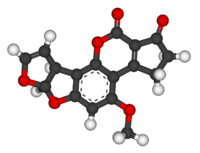Aflatoxin B1
-Aflatoxin_B1_Structural_Formulae_V.1.svg.png) Chemical structure of (–)-Aflatoxin B1 | |
 3D Structure of aflatoxin B1 | |
| Identifiers | |
|---|---|
| ChEMBL | ChEMBL1697694 |
| ChemSpider | 13758 |
| |
| Jmol-3D images | Image |
| PubChem | 14403 |
| |
| Properties | |
| Molecular formula |
C17H12O6 |
| Molar mass | 312.27 g·mol−1 |
| Hazards | |
| Main hazards | Very Toxic |
| Except where noted otherwise, data is given for materials in their standard state (at 25 °C (77 °F), 100 kPa) | |
| | |
| Infobox references | |
Aflatoxin B1 is an aflatoxin produced by Aspergillus flavus and A. parasiticus. It is arguably the most potent carcinogen known, and is up to twice as carcinogenic as an equitoxic dose of X-rays.
Pathology
Aflatoxin B1 can permeate through the skin. Dermal exposure to this aflatoxin in particular environmental conditions can lead to major health risks.[1]
Biosynthetic pathway
Aflatoxin B1 is derived from both a dedicated fatty acid synthase (FAS) and a polyketide synthase (PKS), together known as norsolorinic acid synthase. The biosynthesis begins with the synthesis of hexanoate by the FAS, which then becomes the starter unit for the iterative type I PKS.[2][3][4] The PKS adds seven malonyl-CoA extenders to the hexanoate to form the C20 polyketide compound. The PKS folds the polyketide in a particular way to induce cyclization to form the anthraquinone norsolorinic acid. A reductase then catalyzes the reduction of the ketone on the norsolorinic acid side-chain to yield averantin.[2][3][4] Averantin is converted to averufin via a two different enzymes, a hydroxylase and an alcohol dehydrogenase. This will oxygenate and cyclize averantin's side chain to form the ketal in averufin.
From this point on the biosynthetic pathway of aflatoxin B1 becomes much more complicated, with several major skeletal changes. Most of the enzymes have not been characterized and there may be several more intermediates that are still unknown.[2] However, what is known is that averufin is oxidized by a P450-oxidase, AvfA, in a Baeyer-Villiger oxidation. This opens the ether rings and upon rearrangement versiconal acetate is formed. Now an esterase, EstA, catalyzes the hydrolysis of the acetyl, forming the primary alcohol in versiconal.[2][4] The acetal in versicolorin A is formed from the cyclization of the side-chain in versiconal, which is catalyzed by VERB synthase, and then VerB, a desaturase, reduces versicolorin B to form the dihydrobisfuran.[2][4]
There are two more enzymes that catalyze the conversion of versicolorin A to demethylsterigmatocystin: AflN, an oxidase and AflM, a reductase. These enzymes utilize both molecular oxygen and two NADPH's to dehydrate one of the hydroxyl groups on the anthraquinone and open the quinine with the molecular oxygen.[2][4] Upon forming the aldehyde in the ring opening step, it is oxidized to form the carboxylic acid and subsequently a decarboxylation event occurs to close the ring, forming the six-member ether ring system seen in demethylsterigmatocystin. The next two steps in the biosynthetic pathway is the methylation by S-adenosyl methionine (SAM) of the two hydroxyl groups on the xanthone part of demethysterigmatocystin by two different methyltransferases, OmtB and OmtA.[2][4] This yields O-methylsterigmatocystin. In the final steps there is an oxidative cleavage of the aromatic ring and loss of one carbon in O-methylsterigmatocystin, which is catalyzed by OrdA, an oxidoreductase.[2][4] Then a final recyclization occurs to form aflatoxin B1.
References
- ↑ Boonen, Jente; Malysheva, Svetlana V.; Taevernier, Lien; Diana Di Mavungu, José; De Saeger, Sarah; De Spiegeleer, Bart (2012). "Human skin penetration of selected model mycotoxins". Toxicology 301 (1–3): 21–32. doi:10.1016/j.tox.2012.06.012. PMID 22749975.
- ↑ 2.0 2.1 2.2 2.3 2.4 2.5 2.6 2.7 Dewick, P.M. (2009). Medicinal Natural Products: A Biosynthetic Approach (3rd ed.). Wiley. pp. 122–4. ISBN 0470742798.
- ↑ 3.0 3.1 Singh R, Hsieh DP (January 1977). "Aflatoxin biosynthetic pathway: elucidation by using blocked mutants of Aspergillus parasiticus". Arch. Biochem. Biophys. 178 (1): 285–92. doi:10.1016/0003-9861(77)90193-x. PMID 836036.
- ↑ 4.0 4.1 4.2 4.3 4.4 4.5 4.6 Yu J, Chang PK, Ehrlich KC et al. (March 2004). "Clustered pathway genes in aflatoxin biosynthesis". Appl. Environ. Microbiol. 70 (3): 1253–62. PMC 368384. PMID 15006741.
| ||||||||||||||||||||||||||||||||||||||||||||||||||